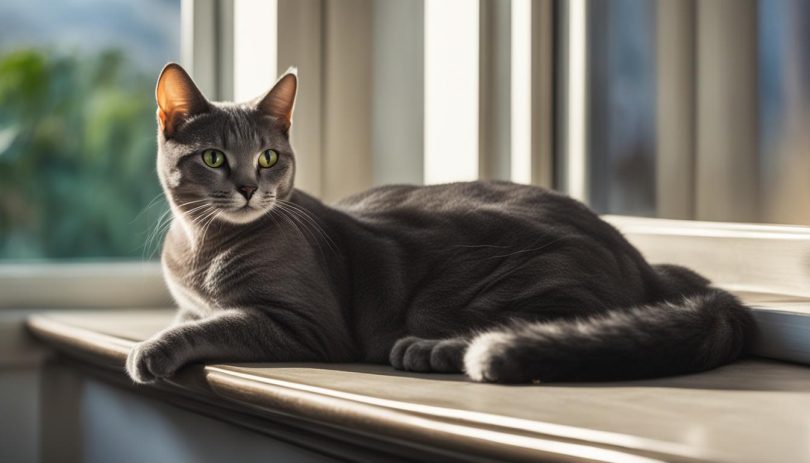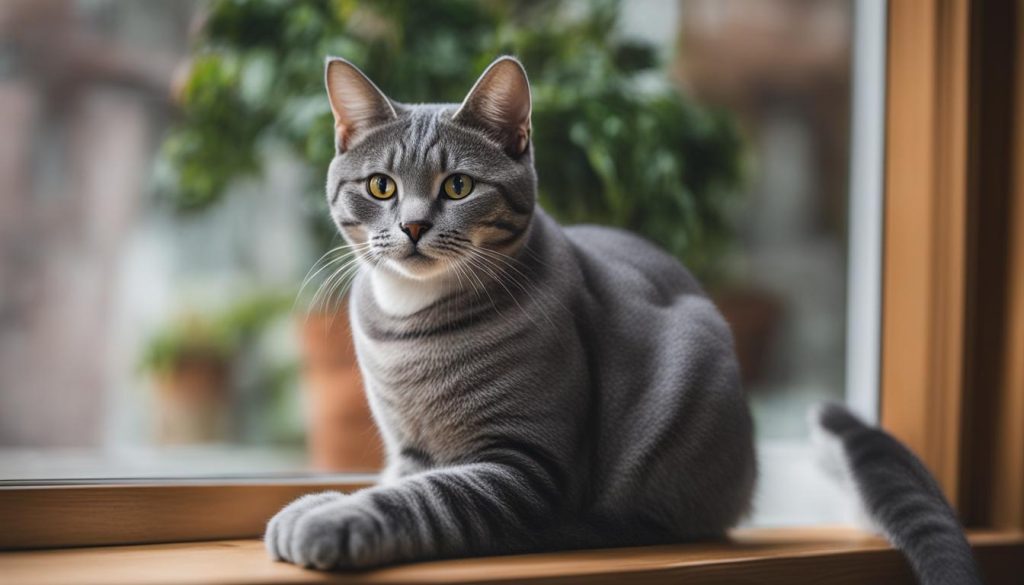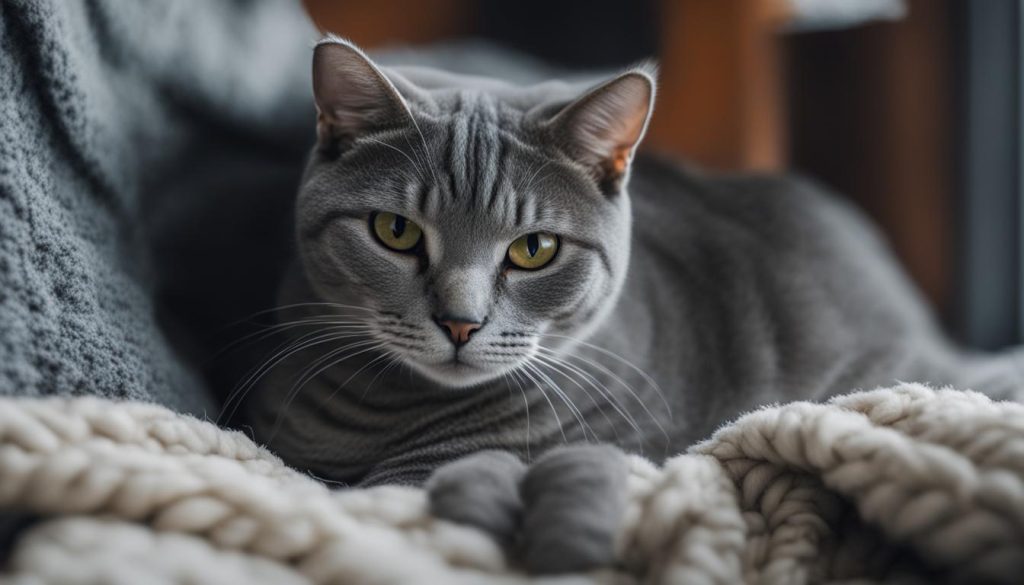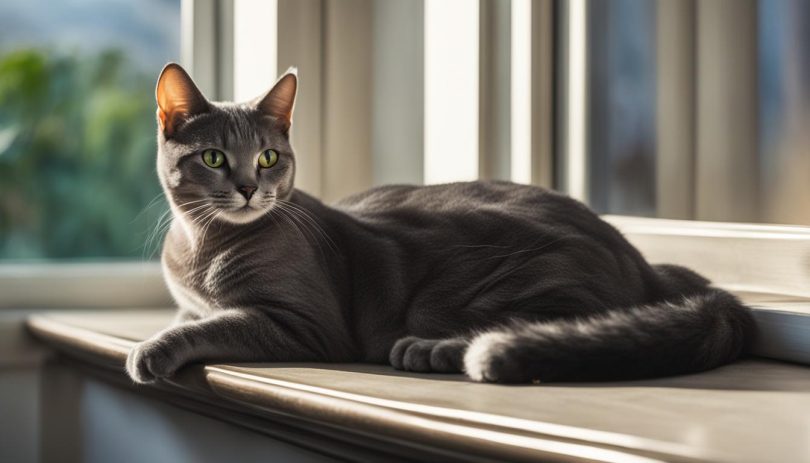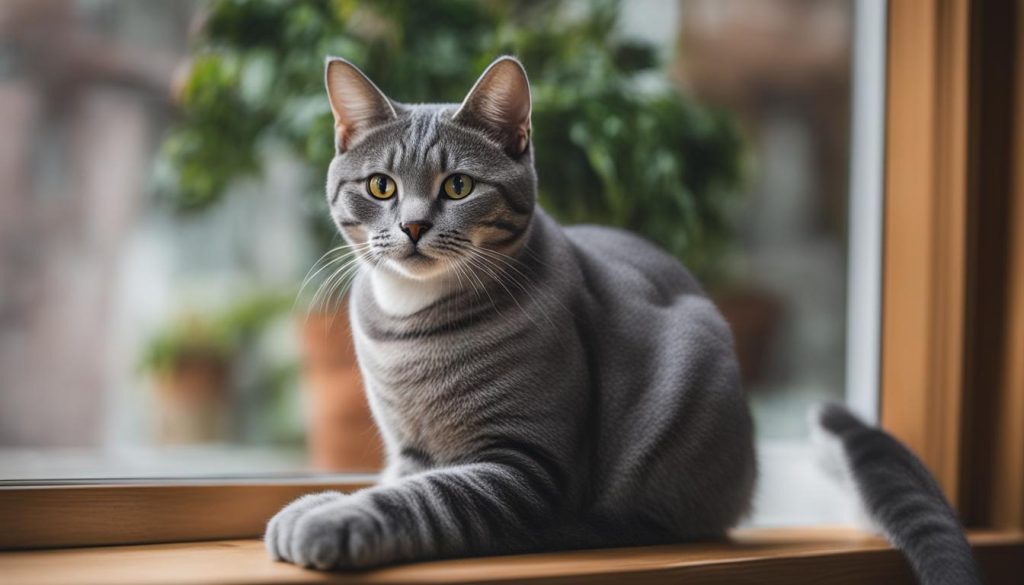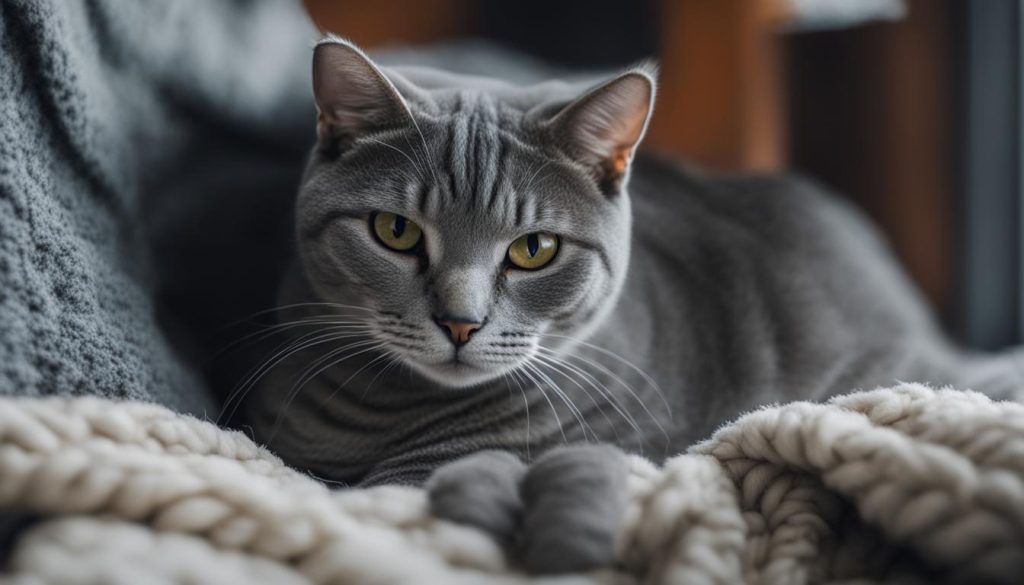I’m here to share with you the enchanting world of the Grey European Shorthair, a captivating breed known for its irresistible charm and unique qualities. If you’re searching for a loving and sociable feline companion, look no further. Let me introduce you to this wonderful grey cat breed that has won the hearts of families throughout Europe.
Originating in Sweden, the Grey European Shorthair, also known as Celtic Shorthair and European, has become a favorite among cat lovers. With a medium-sized body, weighing between 8-15 pounds, and a life expectancy of 15-20 years, these cats are perfect for those seeking a long-term furry friend.
The Grey European Shorthair possesses a calm and friendly temperament, making them a popular choice for families. Their high level of affection and sociability ensures that they will quickly become an integral part of your household. Whether you’re looking for a playmate for children or a companion for other pets, this breed is known for getting along well with everyone.
If you’re ready to experience the joy and companionship that a Grey European Shorthair can bring to your life, I invite you to explore the following sections to learn more about their characteristics, temperament, care, history, and where to find them. Get ready to fall in love with this wonderful grey cat breed!
Key Takeaways:
- The Grey European Shorthair is a captivating breed known for its charm and unique qualities.
- Originating in Sweden, this medium-sized cat is popular among families throughout Europe.
- With a calm and friendly temperament, the Grey European Shorthair is a great choice for those seeking a loving and social feline companion.
- They get along well with children, other cats, and even well-behaved dogs.
- When adopting a Grey European Shorthair, it’s important to find reputable breeders or explore local shelters and rescue groups.
Grey European Shorthair Characteristics
The Grey European Shorthair is a captivating breed with distinct characteristics that set it apart from other cats. Known for its calm, dependable, and independent nature, this breed is extremely friendly and gets along well with children, other cats, and even well-behaved dogs. They have a reputation for being somewhat territorial, so it’s important to choose a cat with a compatible personality when introducing them to existing pets.
Grey European Shorthairs are also known for their love of sleep, often finding cozy spots for lounging and napping. Despite their calm and friendly demeanor, they may exhibit some territorial behaviors, so providing them with a compatible environment and considering their socialization needs is essential. When considering adopting a Grey European Shorthair, it’s advisable to find reputable breeders who specialize in this particular breed.
Grey European Shorthair Characteristics
| Traits | Description |
|---|---|
| Temperament | Friendly, playful, and affectionate |
| Compatibility | Gets along well with children, cats, and dogs |
| Territorial | Possessive of their space, may exhibit territorial behaviors |
| Sleep Patterns | Enjoys sleeping and lounging in cozy spots |
| Socialization Needs | Requires a compatible environment and socialization |
In summary, the Grey European Shorthair is a breed known for its calm, friendly, and sociable nature. They make great companions for those looking for a loving and social feline companion. With their independent yet affectionate personalities, they bring joy and companionship to any home. When considering adopting a Grey European Shorthair, it’s important to understand their characteristics and find reputable breeders who specialize in this breed.
Grey European Shorthair Temperament
The Grey European Shorthair is known for its friendly and fun-loving temperament. With a playful yet gentle nature, they are an ideal addition to any household. They enjoy interactive play sessions and are always up for a game of chase or batting around a toy. But don’t be fooled by their playful antics, as they also have a love for relaxation and cuddling. After an energetic playtime, they will happily curl up in your lap or snuggle next to you for a cozy nap.
Due to their friendly nature, Grey European Shorthairs get along well with children and other pets, making them a great choice for families. However, it’s important to note that they may display some territorial behaviors. To ensure a harmonious environment, it’s essential to provide them with a compatible socialization experience and introduce them gradually to existing pets.
“The Grey European Shorthair is not only playful, but they are also very affectionate. They thrive on human companionship and enjoy being part of the family. Their gentle demeanor makes them an excellent choice for those who seek a furry friend to share quiet moments with.”
Creating a stimulating environment with plenty of toys, scratching posts, and interactive play sessions will help satisfy their natural instincts and keep them mentally and physically engaged. Regular exercise is important for their overall well-being and can help prevent behavioral issues that can arise from pent-up energy.
Grey European Shorthair Temperament Summary
- The Grey European Shorthair has a friendly and fun-loving temperament.
- They enjoy interactive play sessions and are always up for a game.
- They have a love for relaxation and cuddling, making them great companions.
- They get along well with children and other pets, but may display territorial behaviors.
- A stimulating environment with plenty of toys and exercise is essential for their well-being.
Grey European Shorthair Care
The Grey European Shorthair is a low-maintenance breed when it comes to grooming and overall care. Here are some key considerations to keep in mind:
Diet:
Provide your Grey European Shorthair with a balanced and high-protein diet. Choose cat food that has real meat or fish as the primary ingredient. Avoid feeding your cat foods with excessive fillers or artificial additives. Consult with your veterinarian to determine the appropriate portion size based on your cat’s age, weight, and activity level.
Grooming:
The short, dense coat of the Grey European Shorthair requires minimal grooming. However, regular brushing can help keep their fur in good condition and reduce shedding. Use a soft brush or grooming mitt to gently remove loose hair. It’s also important to regularly check their ears for any signs of infection or debris and clean them with a veterinarian-recommended solution if necessary. Trim their nails regularly to prevent them from becoming too long or sharp.
Exercise and Play:
While the Grey European Shorthair is generally not an overly active breed, providing them with opportunities for exercise and play is important to keep them mentally stimulated and prevent obesity. Engage them in interactive play sessions using toys that stimulate their natural hunting instincts. Provide them with scratching posts and encourage them to use them instead of furniture for scratching.
Healthcare:
The Grey European Shorthair is generally a healthy breed with no known genetic issues. However, regular veterinary check-ups are essential to monitor their overall health and detect any potential health concerns early on. Ensure that your cat is up to date on vaccinations and flea and tick preventatives. It’s also important to maintain good oral hygiene by brushing their teeth regularly to prevent dental issues.
| Care Guidelines for Grey European Shorthair | Details |
|---|---|
| Diet | High-protein diet with real meat or fish as the primary ingredient |
| Grooming | Minimal grooming required; regular brushing and nail trimming |
| Exercise and Play | Provide opportunities for exercise and interactive play sessions |
| Healthcare | Regular veterinary check-ups, vaccinations, flea and tick preventatives, dental care |
“Taking care of a Grey European Shorthair is relatively easy compared to some other breeds. Their short coat requires minimal maintenance, and they are generally healthy cats. However, it’s important to provide them with a balanced diet, regular exercise, and proper healthcare to ensure their well-being.”
Grey European Shorthair History
The Grey European Shorthair has a rich and fascinating history that dates back to ancient Rome. These cats were originally brought by Roman legions to help control rodents and pests in their camps. Over time, these cats became an integral part of the settlements and evolved into Europe’s original house cats.
In Sweden, pedigreed Grey European Shorthairs were developed with the goal of creating a domesticated feline that retained a slightly wild appearance reminiscent of their Roman ancestors. Despite their popularity throughout Scandinavia, the Grey European Shorthair is considered one of Sweden’s rarest cat breeds.
To understand the true origins of the Grey European Shorthair, it is important to recognize its ancient lineage and historical significance. These cats have played a vital role in human settlements for centuries, providing companionship and pest control.
| Grey European Shorthair History | Ancient Rome | Sweden |
|---|---|---|
| Origin | Brought by Roman legions to control rodents in camps | Pedigreed breed developed to retain a slightly wild appearance |
| Popularity | Integral part of European settlements | Considered one of Sweden’s rarest cat breeds |
| Role | Pest control and companionship | Companionship |
The Grey European Shorthair has a captivating history that can be traced back to its association with ancient Rome. These cats have adapted and evolved over time, becoming a cherished breed with a unique heritage.
Despite their historical significance, finding Grey European Shorthair breeders outside of Europe, particularly in the United States, can be challenging. While they may not be recognized by major cat registries, individuals interested in adopting a Grey European Shorthair should explore local shelters, rescue groups, and reputable breeders specializing in this specific breed.
The Breed Standard of Grey European Shorthair
The Grey European Shorthair is a breed that stands out for its distinctive appearance, which adheres to specific breed standards. Let’s take a closer look at the defining characteristics of this captivating feline:
Appearance
The Grey European Shorthair has a medium to large-sized body that is stocky and muscular. Their legs are strong and well proportioned, supporting rounded paws that provide a solid foundation. This breed boasts a head that is proportionate to the body, featuring a slightly rounded skull and forehead. The medium-sized ears have rounded tips and contribute to the breed’s overall appeal. The eyes of the Grey European Shorthair are rounded and open, showcasing a range of captivating colors such as blue, green, amber, and odd-eyed.
Coat
The coat of the Grey European Shorthair is short, dense, springy, and glossy. They are known to come in various colors and patterns, adding to their uniqueness. The grey European Shorthair cat colors can range from solid shades of grey to beautifully intricate tabby patterns. This breed’s coat is relatively low-maintenance, requiring minimal grooming to keep it in good condition.
| Appearance | Coat |
|---|---|
| Medium to large-sized body, stocky and muscular | Short, dense, springy, and glossy |
| Strong and well-proportioned legs | Various colors and patterns available |
| Slightly rounded skull and forehead | Low-maintenance grooming |
| Medium-sized ears with rounded tips | |
| Round, open eyes in various colors |
Emphasizing the Grey European Shorthair’s unique appearance, their coat and physical attributes contribute to their allure as a breed, showcasing their individuality through various colors, patterns, and inherent charm.
The breed standard of the Grey European Shorthair encompasses both their physical attributes and coat characteristics. This breed’s striking appearance, with its rounded eyes, proportionate body, and short, dense coat, distinguishes them as a captivating feline companion.
Where to Find a Grey European Shorthair Cat or Kitten
If you’re interested in adding a Grey European Shorthair cat or kitten to your family, there are a few options to consider. While these cats are more prevalent in Europe, particularly in Scandinavia, they can also be found in other parts of the world, including the United States. However, due to their rarity, finding a Grey European Shorthair may require some research and patience.
One option is to explore local animal shelters and rescue groups. These organizations often have a variety of cat breeds available for adoption, including the Grey European Shorthair. Adopting from a shelter not only gives a loving home to a deserving cat but also provides an opportunity to save a life.
If you prefer to work with a breeder, it’s important to find a reputable one who specializes in Grey European Shorthairs. A good breeder will prioritize the health and well-being of their cats and kittens, ensuring they have proper socialization and veterinary care. They should also be able to provide you with documentation and information about the cat’s lineage and any necessary vaccinations or screenings.
When contacting breeders, ask questions about their breeding practices, the cats’ living conditions, and any health guarantees they offer. It’s also a good idea to visit the breeder’s facility in person to see the cats and their living conditions firsthand.
Table: Online Resources for Finding Grey European Shorthair Breeders
| Website | Description |
|---|---|
| Grey Society | A community and resource for Grey European Shorthair enthusiasts and breeders. |
| European Shorthair Association | An international organization dedicated to promoting and preserving the European Shorthair breed. |
| National Cat Club | A UK-based organization that hosts cat shows and provides breeder listings. |
| The International Cat Association (TICA) | An international cat registry that maintains a directory of breeders, including those specializing in Grey European Shorthairs. |
By exploring these resources and reaching out to reputable breeders or local shelters, you can increase your chances of finding a Grey European Shorthair cat or kitten that will bring joy and companionship to your home.
Other Grey Cat Breeds
While the Grey European Shorthair is a fascinating breed, there are several other grey cat breeds that deserve attention. Each of these breeds brings its own unique characteristics and charm to the table.
Russian Blue
The Russian Blue is known for its stunning blue-grey coat and enchanting green eyes. This breed is playful and intelligent, often forming strong bonds with their human companions. They are generally reserved around strangers but warm up quickly to those they trust.
Korat
Originating in Thailand, the Korat is a captivating breed with a blue-grey coat that is tipped in silver, giving it an ethereal appearance. Korats are known for their loyalty and devotion to their families, often forming deep connections. They are playful and adventurous, making them a great choice for active households.
Chartreux
The Chartreux is a French breed with a robust body and a dense blue-grey coat. These cats have a calm and composed temperament, making them perfect companions for those seeking a relaxed and peaceful feline friend. Chartreux cats are known for their intelligence and gentle nature.
Nebelung
The Nebelung is a medium-long-haired cat with a beautiful blue-grey coat, often described as having a shimmering silver sheen. They are known for their reserved and gentle nature, making them ideal companions for quiet and tranquil households. Nebelungs are attentive and loyal to their owners.
British Shorthair
The British Shorthair, often referred to as British Blue, has a dense and plush grey coat, giving them a charming teddy bear-like appearance. These cats are calm and composed, often enjoying a laid-back lifestyle. They are known for their independent nature and can be quite content spending time alone.
Exploring these other grey cat breeds can provide a range of options for those seeking a feline companion with a grey coat. Whether you’re drawn to the playful nature of the Russian Blue, the ethereal beauty of the Korat, the calm and composed demeanor of the Chartreux, the gentle and reserved personality of the Nebelung, or the independent yet adorable British Shorthair, there is a grey cat breed to suit every preference.
| Breed | Coat Color | Temperament |
|---|---|---|
| Russian Blue | Blue-grey | Playful, intelligent, reserved |
| Korat | Blue-grey with silver tipping | Loyal, playful, adventurous |
| Chartreux | Blue-grey | Calm, composed, intelligent |
| Nebelung | Blue-grey with silver sheen | Reserved, gentle, attentive |
| British Shorthair | Grey | Calm, independent, content |
Fun Facts About Grey European Shorthair Cats
Grey European Shorthair cats have a rich history and unique characteristics that make them fascinating companions. Let’s explore some fun facts about these captivating felines:
National Cat Breed of Finland
Did you know that the Grey European Shorthair is considered the national cat breed of Finland? This esteemed title reflects their popularity and significance in Finnish culture.
Exceptional Mouse-Catching Skills
Grey European Shorthairs are renowned for their exceptional mouse-catching skills. Their keen hunting instincts and agility make them excellent pest controllers, helping to keep homes free from unwanted rodents.
The European Shorthair Confusion
“The British Shorthair was previously known as the European Shorthair, leading to some confusion between these two distinct breeds.”
In the past, the British Shorthair was referred to as the European Shorthair, causing confusion between these two breeds. It’s important to distinguish between the Grey European Shorthair and the British Shorthair to ensure you find the right feline companion for your home.
| Grey European Shorthair | British Shorthair |
|---|---|
| Originated in Sweden | Originated in the United Kingdom |
| Distinctive grey coat | Comes in various colors, including grey |
| Considered rare in many regions | More widely recognized and available |
These fun facts add to the allure and mystique of the Grey European Shorthair. Whether they’re representing a nation or showcasing their hunting prowess, these cats are truly remarkable companions.
Conclusion
After exploring the fascinating world of Grey European Shorthair cats, it’s clear that their charming temperament sets them apart from other breeds. Their calm and friendly nature make them ideal companions for individuals and families alike, providing endless love and companionship.
With their independent yet affectionate personalities, Grey European Shorthair cats bring joy and warmth to any home. Their beautiful grey coats add to their allure and make them truly captivating. Although finding a Grey European Shorthair may require some effort in certain areas, the rewards of their love and companionship are well worth the search.
Whether you’re seeking a calm and gentle pet or a playful and loving companion, the Grey European Shorthair cat is a wonderful choice. Their unique temperament and irresistible charm make them the perfect addition to any household. Consider welcoming a Grey European Shorthair into your life and experience the joy they bring every day.
FAQ
What is the Grey European Shorthair?
The Grey European Shorthair is a breed known for its captivating attributes and irresistible charm. It is also known as the Celtic Shorthair or European Shorthair.
What is the temperament of the Grey European Shorthair?
The Grey European Shorthair is known for its calm, friendly, and independent nature. They are extremely friendly and get along well with children, other cats, and well-behaved dogs.
How should I care for a Grey European Shorthair?
The Grey European Shorthair requires a high-protein diet, regular grooming, teeth brushing, and nail trimming. They also benefit from active play and regular exercise to prevent obesity.
Where can I find a Grey European Shorthair cat or kitten?
Finding a Grey European Shorthair may be more challenging, but it’s advisable to explore local shelters and rescue groups, as well as reputable breeders specializing in this breed.
Are there other grey cat breeds I should consider?
Yes, other grey cat breeds worth exploring include the Russian Blue, Korat, Chartreux, Nebelung, and British Shorthair.
What are some fun facts about Grey European Shorthair cats?
Grey European Shorthair cats are considered Finland’s national cat breed and are known for their exceptional mouse-catching skills. They also have a unique history and were previously known as the European Shorthair in Britain.
